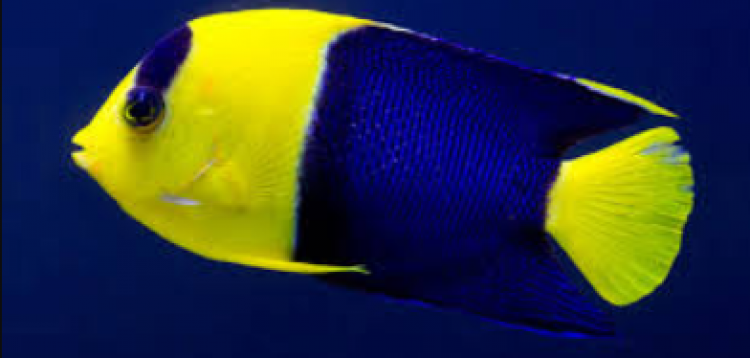- Name:
Lamarcks Angelfish
(View AKA's) - Family: Pomacanthidae
- Species: Angel Large
- Scientific Name: Genicanthus lamarck


General info about Lamarcks Angelfish
The Lamarck's Angelfish have the distinction among angelfish of being sexually dimorphic. Both male and female are a silvery-gray with horizontal black stripes from eye to caudal fin. The female's stripes are bolder with one extending into and covering the length of the caudal fin. In both, the long dorsal fin is black, although larger in the female, and the caudal fin is freckled with black. More easily kept than some other angelfish, the Lamarck's Angelfish requires a well-maintained in a large tank. They may chase small, docile planktivores such as Anthias, Fairy Wrasses, Flasher Wrasses, and Fire Gobies but will usually ignore other fish, including other Angels. Only one male Lamarck's Angelfish should be kept per tank. Fish of the genus Genicanthus are the only zooplanktivores among the angelfish.
Lamarcks Angelfish Diet & Nutrition
The Lamarck's angelfish is known for being a planktivore in the wild. However, they can be readily fed with a variety of live, frozen, and prepared formula food in an aquarium setting. Their diet must consist of finely chopped shrimp, fish, squid and mussels, spirulina, diatoms and algae.
Determining Sex of Lamarcks Angelfish
Sexual dimorphism is observed for this species of large angelfish, with the male being the larger individual with longer tail fin streamers and a blue spot at the base of their pectoral fin. Females, on the other hand, are smaller and have a wide arcing horizontal stripe that crosses over the caudal peduncle.
Breeding & Spawning Lamarcks Angelfish
Breeding for Lamarck's angelfish has been done succesfully in large display aquarium (~1,300 gallon) which helped encourage spawning for this angelfish.
Lamarck's angelfish are broadcast spawners. They follow a courting behavior where the male and female do a courting 'dance' at the top part of the water column. Spawning usually occurs before sunset when the female extends all her fins as she swims next to the male. The male then goes under the female to nuzzle her belly and then darts downward to release his sperm. The female then turns to her side to release her eggs. External fertilization then occurs.
Common Diseases with Lamarcks Angelfish
Lamarck's angelfish are susceptible to diseases that are borne within the captive saltwater environment such as Saltwater Ich or White spot Disease and Marine Velvet Disease. They are also vulnerable to viral infections such as Lymphocystis which are small nodules on the fish fins and mouth. This angelfish is also prone to contract parasitic infections such as monogenetic flukes.
Lamarcks Angelfish Origin
This angelfish is widely distributed in the tropial waters in the Indo-West Pacific. It ranges from the Indo-Malayan region, eastward to Vanuatu, north to Souther Japan, and then southward to the Great Barrier Reef.
Caution with Lamarcks Angelfish
Placing 2 male Lamarck's angelfish in the tank may initiate sparring between the individuals, resulting in one turning back to female. They are relatively peaceful angelfishes. However, they are known to chase smaller food competitors such as fairy wrasses, flasher wrasses, anthias, tilefish, Chromis damselfish, fire gobies and Creole Wrasses.
Acclimating Lamarcks Angelfish
A single Lamarck's angelfish may be kept in a 75 gallon tank while tanks over 100 gallons is recommended when keeping 2 or more individuals. The aquarium must be kept with the following water parameters: 72-81° F, pH 8.0-8.4, sg 1.023-1.025. Water in the tanks must be changed bi-weekly.
Original Detail
| Name | Species | Family | Scientific Name | More Detail | Added by |
|---|---|---|---|---|---|
| Lamarcks Angelfish | Angel Large | Pomacanthidae | Genicanthus lamarck | The Lamarck's Angelfish have the distinction among angelfish of being sexually dimorphic. Both male and female are a silvery-gray with horizontal black stripes from eye to caudal fin. The female's stripes are bolder with one extending into and covering the length of the caudal fin. In both, the long dorsal fin is black, although larger in the female, and the caudal fin is freckled with black. More easily kept than some other angelfish, the Lamarck's Angelfish requires a well-maintained in a large tank. They may chase small, docile planktivores such as Anthias, Fairy Wrasses, Flasher Wrasses, and Fire Gobies but will usually ignore other fish, including other Angels. Only one male Lamarck's Angelfish should be kept per tank. Fish of the genus Genicanthus are the only zooplanktivores among the angelfish. |
PalaciosAn |
Changed by users
| Submitted Date | Submitted By | Status | Action |
|---|



